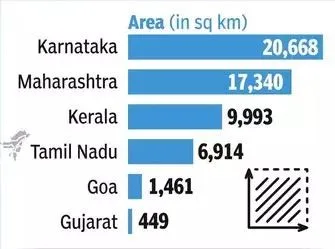Syllabus: GS3/Biodiversity and Conservation
Context
- The Union Government issued the sixth draft notification designating approximately 56,825.7 square kilometers of the Western Ghats as an Ecologically Sensitive Area (ESA) spanning six states: Gujarat, Maharashtra, Goa, Karnataka, Kerala, and Tamil Nadu.

About
- The notification aims to protect the rich biodiversity of the Western Ghats by imposing restrictions on activities such as mining, quarrying, and large-scale construction within the ESA.
- It had provided the states a 60-day window seeking their views and objections on the villages demarcated as ESA.
Eco-Sensitive Zone (ESZ)
- In 2002, it was decided that an area around each Protected Areas, requires to be notified as an Eco-Sensitive Zone for creating a buffer as further protection around Protected Areas (PAs).
- The very purpose of declaring ESZ is to create some kind of “Shock Absorber” for the specialized Ecosystem, such as protected areas or other natural sites.
- Ecologically Sensitive Areas (ESA) have unique biological resources, which require special attention for their conservation.
- These areas often contain rare or endangered species, critical habitats, unique ecosystems, or vital natural resources that are essential for maintaining biodiversity and ecosystem functions.
- On the basis of proposals and recommendations of the State Government, the Ministry notified the ESZs under the Environment (Protection) Act, 1986.
Need to Declare Western Ghats as ESAs
- The entire Western Ghats is the second most landslide-prone region of the country after the Himalayas.
- Absence of ESA cover to Western Ghats resulted in continuation of several environmentally-hazardous human activities, including massive deforestation for mining and construction over the years, leading to loosening of soil and affecting hillside stability.
- Biodiversity: The Western Ghats are considered one of the 8 “hottest hotspots” of biological diversity in the world.
- Covering an area just under 6% of India, the Western Ghats contain more than 30% of all plant, fish, herpeto-fauna, bird, and mammal species found in India.
- Many species are endemic, such as the Nilgiri tahr (Hemitragus hylocrius) and the lion-tailed macaque (Macaca silenus).
- 50% of India’s amphibians and 67% of fish species are endemic to this region.
- The Western Ghats perform important hydrological and watershed functions.
- Approximately 245 million people live in the peninsular Indian states that receive most of their water supply from rivers originating in the Western Ghats.
- Conservation: In 2012, the Western Ghats were inscribed as a UNESCO World Heritage Site due to their exceptional biodiversity and ecological value.
- Several areas of the Western Ghats are designated as protected areas, including national parks and wildlife sanctuaries like Silent Valley National Park, Periyar Wildlife Sanctuary, and Agasthyakoodam.
State’s Reaction
- The Chief Ministers argued that the proposed conservation schemes were too restrictive to allow any development work in the hills that run parallel to the western coast.
- Maharashtra and Goa sought a reduction in the extent of ESA within the respective states for allowing development works.
- The then govt in Karnataka urged the Centre in 2022 to withdraw the draft arguing that it would adversely affect the livelihood of the people in the state.
- The illegal mining lobby and tourism industry put pressure on the government to delay the notification.

Recommendations of Committees on Western Ghats
- Gadgil Report (2011)
- Recommended declaring the entire Western Ghats as an ESA.
- Strong focus on restricting developmental activities across the region.
- Three-tier categorization of the region: It created three categories of protection regimes and listed activities that would be allowed in each based on the level of ecological richness and land use.
- Emphasized forest rights and sustainable livelihoods.
- The report recommended the creation of a Western Ghats Ecological Authority (WGEA) at both the national and state levels to monitor and enforce conservation efforts.
- Environmentalists supported, but state governments and industries strongly opposed.
- Kasturirangan Report (High-Level Working Group Report, 2013)
- Recommended declaring only 37% of the region as an ESA.
- Focused on regulating development in identified sensitive areas while allowing more flexibility in other regions.
- Focused on core ecologically sensitive areas.
- Focused more on development balance and economic activities.
- Recognized the importance of sustainable livelihoods, but with less emphasis on forest rights.
- Argued for strengthening the existing framework of environmental clearances and setting up of a state-of-the-art monitoring agency.
- State governments and industries found it more balanced, though some environmentalists felt it was too lenient.
Conclusion
- The Western Ghats are inhabited even in the areas categorised as natural landscapes.
- It is not possible to plan for Western Ghats only as a fenced-in wilderness zone.
- This is the difference between the natural landscapes of a densely populated country like India and the wilderness zones of many other countries.
- Policymakers have to create a fine balance and promote a development that is sustainable in the cultural and natural landscapes.
Source: IE
Previous article
RNA Editing Promises to Go Where DNA Editing Can’t